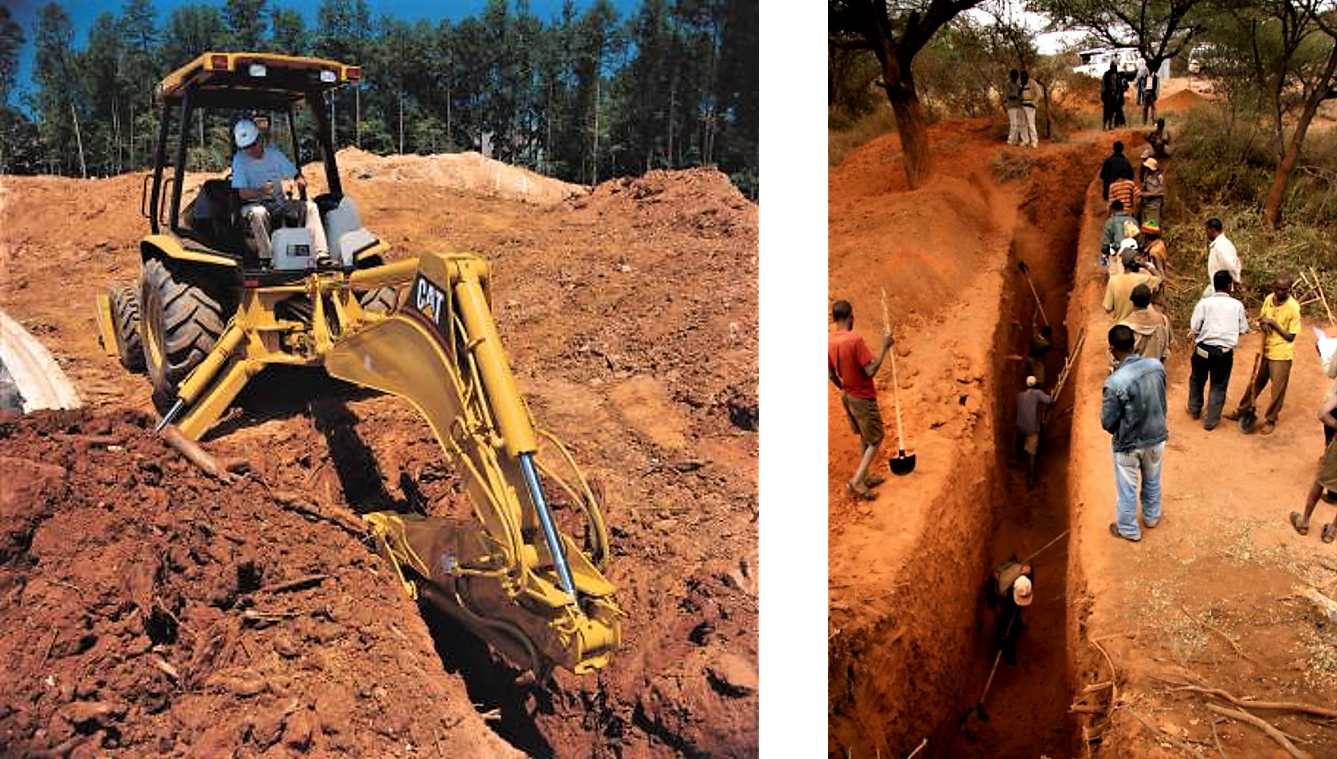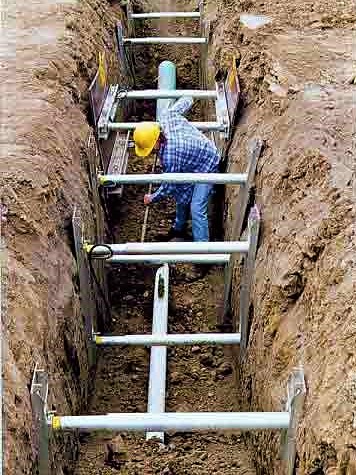Executive Summary
Before an underground water pipe can be installed, a trench must be excavated. Trench dimensions depend on pipe size, soil, and climate. Mostly, the excavation is done by hydraulic backhoes, as they are easy to operate and provide good control. Costs depend on the local conditions (machinery, soil, etc.). It is very important that safety regulations are properly implemented to avoid accidents.
Introduction
The most expensive part of pipe installation (either sewer pipes, e.g. conventional or drinking water pipes), is the excavation of the trenches. Therefore, it should be carried out as economically as possible.
Most trenching for water main installation is done by hydraulic backhoes, which are easy to operate and provide excellent control. The size of the machine should be chosen proportionally to the size of pipe, and respectively to the size of the trenches. Smaller trenches can be made manually if machines are not available, but many labourers are necessary to do it in a reasonable time.

Preparations
Before the work can begin, a plan for the project must be prepared. The plan should include at least the following details:
- The location and depth of the main that is to be installed
- The location of valves, hydrants, and all fittings that can be anticipated
- The location and depth of all sewer and gas pipes, electric, telephone, television and streetlight cables in the line of the new construction
- Details of any other obstructions that must be protected or avoided
Basic design principles
Trench width
If work is done by a backhoe, the appropriate bucket width to use is based on pipe size, trench depth and local experience concerning soil conditions. On the other hand, the trench width should be minimised to save time and possible site damages, yet, as already mentioned, wide enough to allow proper installation, i.e. there should be enough room to make up the pipe joints, tamp backfill under and around the pipe, and maintain the trench wall.
Generally, the trench width should be no more than 0.3 to 0.6 m greater than pipe diameter. Especially under paved areas, it is important to keep the trench width as narrow as possible to minimise the traffic load that will be transmitted down through the backfill and exerted on the pipe. If there are unusually heavy surface loads, special installation recommendations should be considered.
Trench depth
In warmer climates, the depth is designed to sufficiently spread surface loading and protect the pipe from damage. The minimum cover for mains is typically 0.8 m, and 0.5 m for water services. In colder areas, the depth is dependent on the maximum depth of frost (knowledge of local conditions necessary). If the pipes are too shallow in such climates, water services will freeze at the point of connection. If adequate burial depth is not possible, the main can be insulated (e.g. closed-cell styrofoam insulation).
Excavation
The excavated material should be piled at least 0.6 metres from shallow trenches. For deeper trenches, it must be piled even further away. This minimises the risk that dirt or stones are kicked into the construction down to a worker or that excavated material falls back. Furthermore, there must be enough space for the labourers to walk along the construction. A safe deposit distance also prevents someone from tripping and falling into the trench. Moreover, the weight of the excavated material must be considered. If it is not deposited correctly, it could lead to a cave-in of the trench.
The bottom of the trench should be buried as close as possible to the specified grade so that it provides a continuous, even support for the pipe. After the pipe has been placed, high points must be levelled out and low points should be filled to provide a good support for the pipe.
Cost considerations
The costs for excavation depend on various criteria. Rocky ground, for example, slows down the excavation, while very sandy and unstable ground must be shored, which requires extra material (see picture above) and knowledge. Furthermore, of course, the size of the trench (depth, width) affects the costs. For very deep and wide trenches, heavy machinery is necessary.
Safety
The excavation should not be started much ahead of pipe laying. The main reason for this is that the longer the construction stays open, the more likely it is to have a cave-in (especially during heavy rainfall). At the end of the day, it is best to be completely backfilled or at least protected by barricades and lights. If there is traffic and the trench cannot be filled, it should be covered with heavy steel plates (HUBEN 2012). If the trench is very deep or soil conditions are bad, the construction should be protected to prevent a cave-in (see picture). Read more about trenching safety in IHSA (1991).

Basically, trenches are required wherever underground water pipes will be installed. As described above, the depth and width of the trench depends on piping size and local conditions. If trenches are very deep or excavated ground is unstable, special safety regulations are required (e.g. vertical shores).
How Caterpillar Backhoe Loaders Work
Water Distribution Operator Training Handbook
Trenching Safety - Introduction to Trenching Hazards
A significant number of deaths and injuries in sewer and watermain work are directly related to trenching. Trenching fatalities are mainly caused by cave-ins. Death occurs by suffocation or crushing when a worker is buried by falling soil. Over half of all powerline contacts involve buried cable. Before excavating, the gas, electrical, and other services in the area must be accurately located and marked. If the service poses a hazard, it must be shut off and disconnected. Read more here.
IHSA (1991): Trenching Safety - Introduction to Trenching Hazards. Mississauga: Infrastructure Health & Safety Association URL [Accessed: 16.05.2019]Hydraulic Shoring
Safe Piped Water: Managing Microbial Water Quality in Piped Distribution
This review looks at the factors affecting the presence and growth of microorganisms in piped networks, and the practices of water supply organisations that can directly or indirectly influence their presence and growth. This review is intended for policymakers but it is also relevant to engineers and scientists responsible for water supply planning, operations and monitoring.
AINSWORTH, R. (2004): Safe Piped Water: Managing Microbial Water Quality in Piped Distribution. Geneva: World Health Organization (WHO) URL [Accessed: 13.05.2019]Guide to Trench Excavations. Shoring Support and Drainage Measures
The study concludes that the risk from trench excavations is not low. A Working Group was therefore formed under the Utilities Technical Liaison Committee (UTLC) of Highways Department to prepare guidelines to promote safe practice for trench excavations. This document presents the recommendations of the Working Group as part of the Government’s continuing effort to promote a safe and healthy working environment for all personnel in construction sites and others who may be affected by the works.
CED (2003): Guide to Trench Excavations. Shoring Support and Drainage Measures. Hongkong: Civil Engineering Department (CED) URL [Accessed: 02.05.2012]Trenching Safety - Introduction to Trenching Hazards
A significant number of deaths and injuries in sewer and watermain work are directly related to trenching. Trenching fatalities are mainly caused by cave-ins. Death occurs by suffocation or crushing when a worker is buried by falling soil. Over half of all powerline contacts involve buried cable. Before excavating, the gas, electrical, and other services in the area must be accurately located and marked. If the service poses a hazard, it must be shut off and disconnected. Read more here.
IHSA (1991): Trenching Safety - Introduction to Trenching Hazards. Mississauga: Infrastructure Health & Safety Association URL [Accessed: 16.05.2019]Excavations (1 of 6): Introduction
This six-part video demonstrates the common hazards associated with excavations, plus the procedures for preparing and working in a trench.

